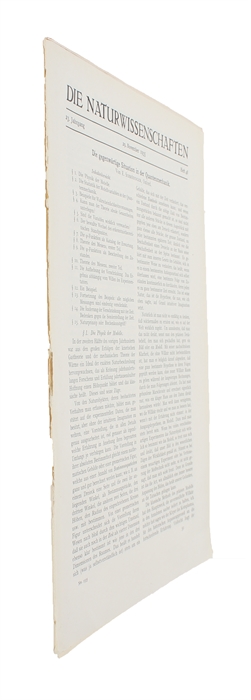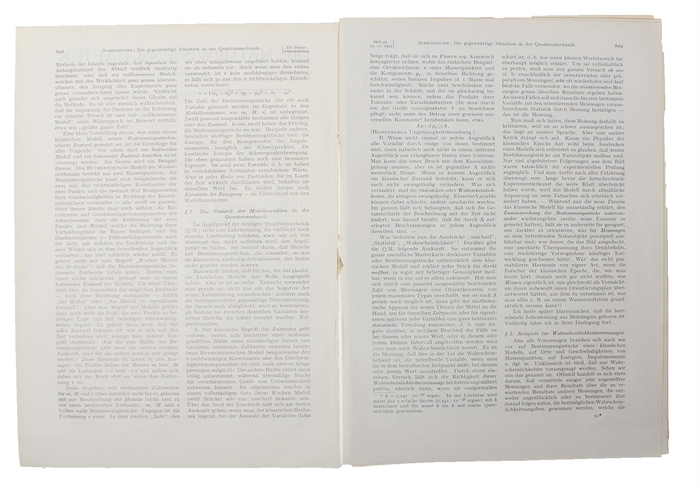SCHRÖDINGER'S CAT
SCHRÖDINGER, ERWIN.
Die gegenwärtige Situation in der Quantenmechanik I-II. (The Present Situation in Quantum Mechanics).
Berlin, Springer, 1935.
Royal8vo. As extracted from "Die Naturwissenschaften", vol. 23, 1935. No backstrip. Fine and clean. Pp. 807-812; 823-828.
First edition and first announcement of Schrödinger's famous reply to the EPR-paradox (also known as Schrödinger's Cat).
When in May 1935 Einstein, Podolsky and Rosen published the so-called EPR-paper in "Physical Review", they set out to demonstrate that the Copenhagen interpretation of quantum mechanics could not constitute a complete description of nature. The EPR-article prompted a number of responses, e.g. from Bohr, the co-founder of the Copenhagen School, who began writing his response immediately after the publication of the Physical Review article. It is this debate that Schrödinger participates in with his seminal paper on "The Present Situation in Quantum Mechanics", in which he presents what is now famously known as Schrödinger's Cat. Schrödinger's Cat is the name of the thought experiment that Schrödinger develops in this article and that was intended as a discussion of the EPR article.
After the publication of the EPR article, Einstein and Schrödinger had begun an exchange of letters on the subject of the possibility of quantum mechanics, as interpreted by the Copenhagenists, representing reality. During this exchange of letters, Schrödinger had been inspired by Einstein's view of the problem of applying the Copenhagen interpretation of Quantum mechanics to everyday objects. But Schrödinger, in his response, took his illustration of the absurdity of the interpretation and the incompleteness of quantum mechanics a step further; he applied it to a living entity, namely a cat.
Schrödinger imagines a sealed box containing a cat, a bottle of poison, a radioactive source, a Geiger counter and a hammer. When the Geiger counter detects radiation, a mechanism is switched on that makes the hammer fall; the hammer breaks the bottle, and the poison kills the cat. Because it is random, when the Geiger counter will detect radiation, and because in Quantum mechanics, physical conditions are described with the aid of a wave-function that explains all possible conditions of the system, Quantum mechanics, according to the Copenhagen interpretation, would come to the conclusion that the cat in the box is both living and dead, at the same time (the wave function is made up of a superposition of the two conditions -the cat being living and the cat being dead-; the two positions collapse into one, as soon as the system is interpreted as consisting of only one condition -either dead or living cat-, with the sole possible conclusion that the cat is both).
Due to Heisenberg and Bohr's independent interpretation of Quantum theory (the "Copenhagen interpretation), Quantum theory had in 1927 developed in a direction unforeseen by Schrödinger. "Schrödinger was "concerned and disappointed" that this "transcendental, almost physical interpretation of the wave phenomena" had become the "almost universally accepted dogma."" (D.S.B. XII, p. 221). His most famous and widely used attack on this interpretation was that of "Schrödinger's Cat".
This paradox of the dead-and-alive cat vigorously illustrated the absurdity of quantum mechanics and what was necessary to describe the states within this system. The thought experiment of Schrödinger's cat turned out to be hugely influential, and has become a standard paradox within both physics and philosophy.
Order-nr.: 49055


